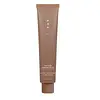What's inside
What's inside
 Key Ingredients
Key Ingredients

 Benefits
Benefits

 Concerns
Concerns

 Ingredients Side-by-side
Ingredients Side-by-side

Water
Skin ConditioningOctyldodecanol
EmollientCaprylic/Capric Triglyceride
MaskingIsopropyl Myristate
EmollientGlycerin
HumectantCetearyl Alcohol
EmollientButylene Glycol
HumectantDimethicone
EmollientPEG-100 Stearate
Cyclohexasiloxane
EmollientCyclopentasiloxane
EmollientSodium Polyacrylate
AbsorbentPhenoxyethanol
PreservativeBisabolol
MaskingTocopheryl Acetate
AntioxidantCetearyl Glucoside
EmulsifyingHydroxyacetophenone
AntioxidantAllantoin
Skin ConditioningEthylhexylglycerin
Skin ConditioningDisodium EDTA
Caprylyl Glycol
EmollientHydrolyzed Soy Protein
HumectantLactic Acid
BufferingRice Amino Acids
Skin ConditioningCitric Acid
BufferingProline
Skin ConditioningAcetyl Dipeptide-3 Aminohexanoate
Skin ConditioningDiaminopropionoyl Tripeptide-33
Skin ConditioningHydrolyzed Adansonia Digitata Seed Extract
Acetyl Hexapeptide-49
Skin ConditioningWater, Octyldodecanol, Caprylic/Capric Triglyceride, Isopropyl Myristate, Glycerin, Cetearyl Alcohol, Butylene Glycol, Dimethicone, PEG-100 Stearate, Cyclohexasiloxane, Cyclopentasiloxane, Sodium Polyacrylate, Phenoxyethanol, Bisabolol, Tocopheryl Acetate, Cetearyl Glucoside, Hydroxyacetophenone, Allantoin, Ethylhexylglycerin, Disodium EDTA, Caprylyl Glycol, Hydrolyzed Soy Protein, Lactic Acid, Rice Amino Acids, Citric Acid, Proline, Acetyl Dipeptide-3 Aminohexanoate, Diaminopropionoyl Tripeptide-33, Hydrolyzed Adansonia Digitata Seed Extract, Acetyl Hexapeptide-49
Aloe Barbadensis Leaf Water
MaskingDiethylhexyl Succinate
EmollientPropanediol
SolventWater
Skin ConditioningDrometrizole Trisiloxane
UV AbsorberEthylhexyl Triazone
UV AbsorberNiacinamide
SmoothingDiethylamino Hydroxybenzoyl Hexyl Benzoate
UV FilterTerephthalylidene Dicamphor Sulfonic Acid
UV Absorber1,2-Hexanediol
Skin ConditioningBehenyl Alcohol
EmollientMethyl Trimethicone
Skin ConditioningSodium Polyacryloyldimethyl Taurate
Emulsion StabilisingHamamelis Virginiana Leaf Water
AstringentTromethamine
BufferingPolyacrylate Crosspolymer-6
Emulsion StabilisingArachidyl Alcohol
EmollientCaprylyl Glycol
EmollientEthylhexylglycerin
Skin ConditioningArachidyl Glucoside
EmulsifyingSodium Metaphosphate
BufferingAdenosine
Skin ConditioningTocopherol
AntioxidantSodium Hyaluronate
HumectantAllantoin
Skin ConditioningCitric Acid
BufferingSodium Benzoate
MaskingPotassium Sorbate
PreservativeAloe Barbadensis Leaf Water, Diethylhexyl Succinate, Propanediol, Water, Drometrizole Trisiloxane, Ethylhexyl Triazone, Niacinamide, Diethylamino Hydroxybenzoyl Hexyl Benzoate, Terephthalylidene Dicamphor Sulfonic Acid, 1,2-Hexanediol, Behenyl Alcohol, Methyl Trimethicone, Sodium Polyacryloyldimethyl Taurate, Hamamelis Virginiana Leaf Water, Tromethamine, Polyacrylate Crosspolymer-6, Arachidyl Alcohol, Caprylyl Glycol, Ethylhexylglycerin, Arachidyl Glucoside, Sodium Metaphosphate, Adenosine, Tocopherol, Sodium Hyaluronate, Allantoin, Citric Acid, Sodium Benzoate, Potassium Sorbate
 Reviews
Reviews

Ingredients Explained
These ingredients are found in both products.
Ingredients higher up in an ingredient list are typically present in a larger amount.
Allantoin is a soothing ingredient known for its protective and moisturizingg properties. Because of this, it is often added to products with strong active ingredients.
Studies show higher concentrations of this ingredient can promote wound healing.
Though it can be derived from the comfrey plant, allantoin is produced synthetically for cosmetic products to ensure purity.
Learn more about AllantoinCaprylyl Glycol is a humectant and emollient, meaning it attracts and preserves moisture.
It is a common ingredient in many products, especially those designed to hydrate skin. The primary benefits are retaining moisture, skin softening, and promoting a healthy skin barrier.
Though Caprylyl Glycol is an alcohol derived from fatty acids, it is not the kind that can dry out skin.
This ingredient is also used as a preservative to extend the life of products. It has slight antimicrobial properties.
Learn more about Caprylyl GlycolCitric Acid is an alpha hydroxy acid (AHA) naturally found in citrus fruits like oranges, lemons, and limes.
Like other AHAs, citric acid can exfoliate skin by breaking down the bonds that hold dead skin cells together. This helps reveal smoother and brighter skin underneath.
However, this exfoliating effect only happens at high concentrations (20%) which can be hard to find in cosmetic products.
Due to this, citric acid is usually included in small amounts as a pH adjuster. This helps keep products slightly more acidic and compatible with skin's natural pH.
In skincare formulas, citric acid can:
While it can provide some skin benefits, research shows lactic acid and glycolic acid are generally more effective and less irritating exfoliants.
Most citric acid used in skincare today is made by fermenting sugars (usually from molasses). This synthetic version is identical to the natural citrus form but easier to stabilize and use in formulations.
Read more about some other popular AHA's here:
Learn more about Citric AcidEthylhexylglycerin (we can't pronounce this either) is commonly used as a preservative and skin softener. It is derived from glyceryl.
You might see Ethylhexylglycerin often paired with other preservatives such as phenoxyethanol. Ethylhexylglycerin has been found to increase the effectiveness of these other preservatives.
Water. It's the most common cosmetic ingredient of all. You'll usually see it at the top of ingredient lists, meaning that it makes up the largest part of the product.
So why is it so popular? Water most often acts as a solvent - this means that it helps dissolve other ingredients into the formulation.
You'll also recognize water as that liquid we all need to stay alive. If you see this, drink a glass of water. Stay hydrated!
Learn more about Water